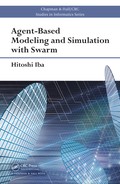
136 Agent-Based Modeling and Simulation with Swarm
FIGURE 5.24: Effect of neighborhood knowledge (Map 1).
FIGURE 5.25: Effect of neighborhood knowledge (Map 2).
neighboring ants showed high performance. This was because the conditions
for bridge formation were relaxed a nd hence bridges could be formed at an
early s tage and food could be found easily.
Map 2 was used to investigate whether intelligent behavior can be achieved
by avoiding unnecessary bridge formation where a shortcut is not especia lly
necessary for food collection. In this case, better results were obtained with
the method that checks the number of neighbor ing ants.
Figure 5.26 shows how the bridges extend in size with time for Map 1.
In the figure, “1st” re fers to the largest bridge at the time and “2nd” refers
to the next la rgest bridge. The horizontal axis shows time and the vertical
axis shows the two largest bridges. It is apparent from the graph that at first
several bridges coexist and extend for ab out the same length, but finally the
differences become gr e ater. Figure 5.27 shows the data obtained in a biological

Ant Colony–Based Simulation 137
FIGURE 5.26: Changes in size of bridge.
FIGURE 5.27: Changes in size of chain (da ta plot from [81]).
exp e riment in the r e search of Lioni et al. [81]. When chains were formed at
two sites, records were kept on how each of the chains ex tended. In the figur e ,
“1st” and “2nd” show the sizes of the chains at each site.
As can be seen from the two figures, these curves, i.e., simulation data and
data from the biological experiment, look quite similar.
5.8.7 Simulation with fixed role assigned
From the previous experiments, it seems that our model has many proper-
ties similar to actual army ant behavior. To emphasize the similarity b e tween
the simulator agents and the actual army ants, it is important to compare
exp e rimental data. We can do that by corresponding the agents’ be havior to
the army ants’ behavior.

138 Agent-Based Modeling and Simulation with Swarm
FIGURE 5.28: Experimental results with task assignment.
As a first s tep, the experiment was performed using a simulator that has
agents with a fix e d task assigned. Task assignment is one of the signatures
that is obse rved in army ants. Army ants have tasks that dep e n d on someone’s
rank. Here we consider two different roles for agents in our simulator.
• role A: Sear ch and trans port food.
• role B: Build a bridge to support role A.
We carried out the experiment by assigning agents to these two roles with
different ratios. Figure 5.28 shows the experimental results where the perfor-
mance was compared in terms of the number of food items collected within
a fixed time. Rate 0.1 means that 10% of the agents were assigned to role B
in the simulation. “Dynamic Assignment” labels the experimental results ob-
tained by the simula tor used in Section 5.8.5 where the agents have no fixed
role.
The results in Fig. 5.28 indicate that a fixed division of roles may be
better than a dynamic one. Particularly, Rate 0.5 and Rate 0.6 are better than
other ratios. Although “Dynamic Assignment” was not the best, it performed
competitively on an average.
This section points out the possibility o f role assignment in our simulator.
In the real world, it is not possible to know the role assignments of ants to
solve this problem. The improvement of Swarm-based simulation with more
realistic knowledge is a future re search concern.
..................Content has been hidden....................
You can't read the all page of ebook, please click here login for view all page.
